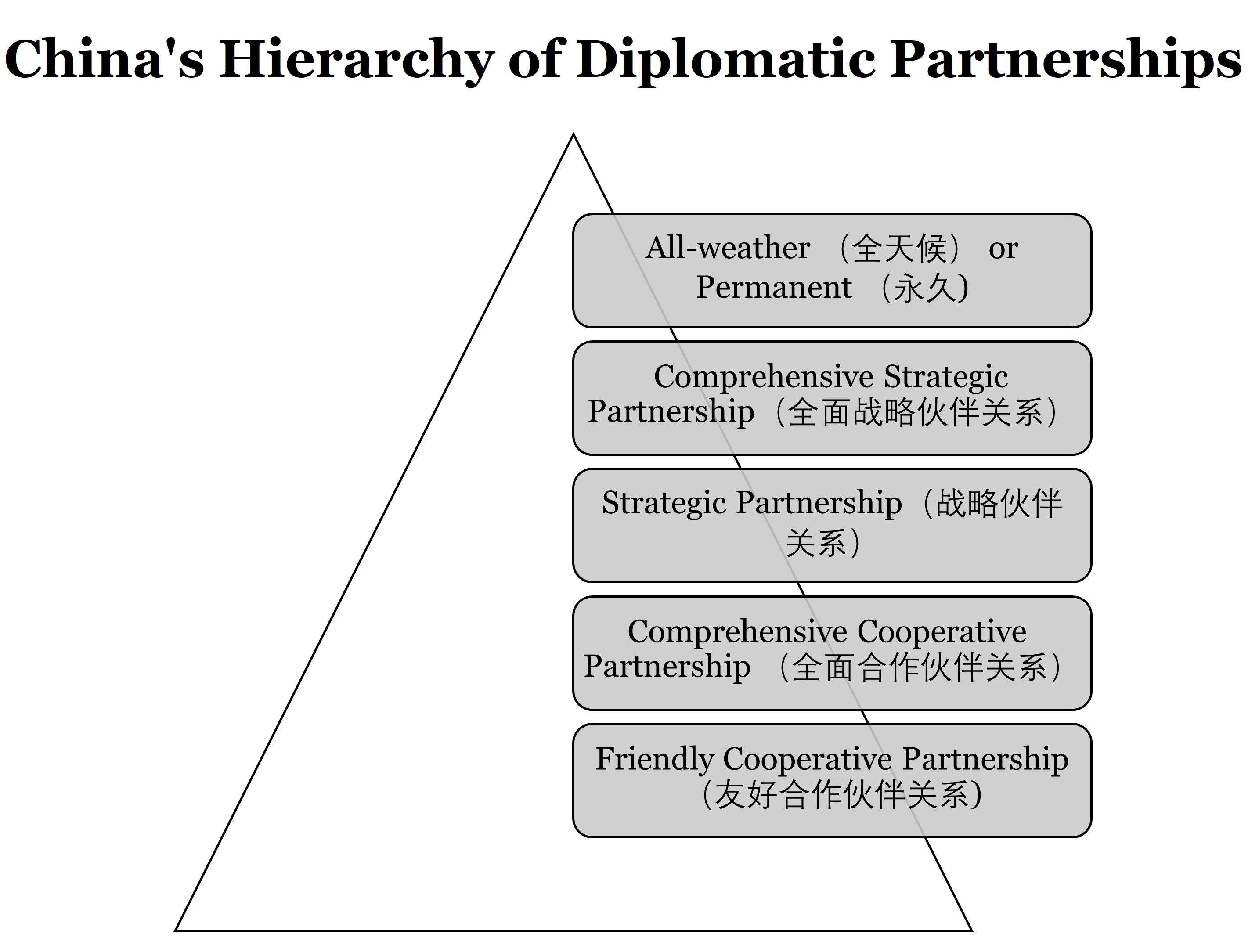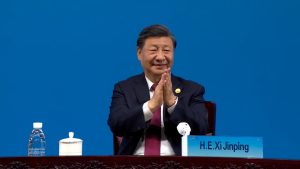In the 21st century, Chinese foreign policy has increasingly focused on building global partnerships and expanding its interests through strategic relationships with other nations. These relationships serve as geopolitical tools for wielding influence and power. Unlike traditional alliances, which typically involve formal defense treaties aimed at external adversaries, China has established a global network of strategic partnerships.
These partnerships entail flexible political cooperation founded on informal political bonds. They are perceived as more adaptable and interest-driven than traditional alliances, which can expose Chinese diplomacy to higher risks. The essence of these partnerships lies in a shared commitment to managing inevitable conflicts that allows the involved countries to continue collaborating on crucial areas of mutual interest. This approach enables China to forge relationships with diverse nations while retaining the flexibility to adapt to evolving geopolitical dynamics and pursue its strategic objectives effectively.
Hierarchical Structure of Partnerships
China employs a nuanced system of descriptors to categorize its international partnerships, highlighting subtle distinctions in its diplomatic relationships. Key terms include “all-weather,” “comprehensive,” “strategic,” and “future-oriented,” each reflecting varying degrees of cooperation and commitment.
While Beijing has never explicitly outlined this hierarchy, enough information exists to infer a general structure. This system is flexible, as the varying levels of partnerships have not been formally defined in official documents. However, insights from Chinese officials and academics, alongside contextual analysis, allow for a rough understanding of the hierarchy, as outlined in the figure below.

Despite its broad scope, the system does not encompass every nation. The United States, for example, is uniquely positioned in China’s diplomatic strategy, remaining outside the established partnership structure.
A key distinction in China’s partnership diplomacy lies between partnerships labeled as “strategic” and those not. At the top of this hierarchy are partnerships described as “all-weather” or “permanent,” which signify exceptionally close and enduring relationships. Until 2019, only Pakistan enjoyed the “all-weather” label, indicating the unique nature of Sino-Pakistani relations. In 2019, Kazakhstan was designated as a “permanent” partner, likely to preserve Pakistan’s exclusivity of the “all-weather” title. Since then, China has expanded the “all-weather” descriptor to more nations, including Belarus in 2022, Venezuela and Ethiopia in 2023, Uzbekistan and Hungary in 2024, and even all of Africa. This signals an increasing circle of close allies under China’s partnership diplomacy framework.
Another significant term is “comprehensive.” While some partnerships are deemed “comprehensive” without being “strategic,” the general progression moves from “strategic” to “comprehensive strategic.” “Cooperative” is a commonly used descriptor, sometimes attached to strategic and non-strategic partnerships. The terms are generally straightforward: “Strategic” denotes long-term, close collaboration on matters of global importance, while “comprehensive” signifies partnerships that span a wide range of cooperative areas.
With 42 distinct combinations of these adjectives, it is evident that China tailors its diplomatic language to fit specific relationships with individual countries. For instance, the United Kingdom has the unique title of “Global Comprehensive Strategic Partnership for the 21st Century,” while Israel is designated as having an “Innovative Comprehensive Partnership.”
Community With a Shared Future and the New Era
The phrases “community with a shared future” and “New Era” have become key concepts in China’s diplomacy under President Xi Jinping. These terms reflect China’s strategic alignment on specific global challenges, particularly the United States. Beijing strategically deploys these phrases in its relationships with individual countries to enhance their diplomatic value.
The concept of the “community with a shared future” is central to “Xi Jinping Thought on Diplomacy,” which encapsulates China’s foreign policy vision for the “New Era.” Since 2017, various translations of the concept (in Chinese, 人类命运共同体) have been introduced, such as “community of common/shared destiny,” “community of common destiny for mankind,” and “community with a shared future.” The term “community with a shared future” was formally adopted to avoid negative associations and present a more globally palatable narrative. The term portrays a vision of global interconnectedness, where all nations coexist harmoniously in a China-led “global village,” and humanity is united as one large family.
By 2023, China had signed bilateral “community with a shared future” agreements with at least 22 countries, while others have acknowledged the concept without formal commitments. The “community with a shared future” is not a distinct level of partnership but rather an additional marker of ideological alignment with Beijing’s global ambitions and a signal of long-term, positive relations.
Similarly, the “New Era,” a term embedded in the Chinese Communist Party’s constitution since 2017, represents the belief that the global balance of power is shifting in China’s favor. Countries labeled “New Era” partners are viewed as more closely aligned with Beijing’s broader geopolitical goals, including resisting U.S. dominance.
Both phrases complicate China’s partnership diplomacy levels, emphasizing ideological alignment and long-term cooperation. As China faces economic challenges and growing tensions with the West, especially in the context of great power rivalry with the United States, it increasingly seeks to forge alliances in the Global South using these diplomatic narratives.
Community of Shared Future and the New Era in Africa and the Middle East
At the 2024 Summit of the Forum on China-Africa Cooperation, China either established or enhanced strategic partnerships with 30 African countries. The overall characterization of Africa-China relations was elevated to an “all-weather community with a shared future for the new era.” This progression – from a new type of partnership to a comprehensive strategic cooperative partnership and now to an all-weather community – marks the deepening of Africa-China ties, bringing greater clarity and substance to their relationship.
In the context of the China-U.S. great power rivalry, this development signifies a new milestone in the shifting global landscape. As U.S. and Western influence in Africa has declined, China has seized the opportunity to expand its presence on the continent. Beijing’s growing influence in Africa has the potential to significantly reshape the global balance of power, challenging Western dominance. This shift could undermine the United States’ global supremacy and threaten its strategic interests while positioning China as a key player in shaping Africa’s future development.
In the Middle East, China has expanded its footprint through diplomacy, energy, trade, investment, and infrastructure initiatives, raising its profile in regional geopolitics. However, despite China’s growing influence, its interdependence with Middle Eastern nations reveals that various constraints temper its ability to project power. These include mutual dependencies, regional dynamics, limited hard power, domestic priorities, geography, and the agency of the Middle Eastern states, all of which impact the extent of China’s influence in the region.
In the competitive region dominated by Washington, Beijing has had to build a regional presence that does not alienate the United States or any Middle Eastern states while pursuing its geopolitical interests, even as the U.S. security umbrella offers a low-cost entry into the region. China’s partnerships with the Middle East states broadly tend to correspond to the three major categories of partnerships: comprehensive strategic partnerships (Egypt, Saudi Arabia, Iran, the UAE, and Bahrain), strategic partnerships (Turkey, Jordan, Qatar, Iraq, Oman, Kuwait, Syria, and Palestine), and an innovative comprehensive partnership (Israel). Through strategic partnerships are usually founded on economic interests, China has pursued its Middle Eastern geopolitical interests bilaterally without adopting region-wide or multilateral goals. As a result, China’s network of partnerships in the region has steadily grown more diverse and expansive, reflecting its increasing influence and strategic adaptability.
In recent years, Arab-China relations in the “New Era” have demonstrated significant vitality and sustained progress, contributing to constructing an Arab-China community with a shared future. China established the China-Arab States Cooperation Forum (CASCF) in 2004 to strengthen ties with Arab nations. At the sixth ministerial conference of the CASCF in 2014, Xi introduced the idea of building a China-Arab community of common interests and a community with a shared future. In 2018, during the 8th ministerial meeting of the CASCF, Xi outlined a strategic partnership focused on comprehensive cooperation, common development, and a future-oriented vision for Arab-China relations. This marked a significant step toward establishing a “China-Arab community with a shared future.”
By 2020, during the 9th ministerial meeting of the CASCF, China and Arab states reached a positive consensus to incorporate the concept of “jointly building a China-Arab community with a shared future in the new era.” In 2022, Xi attended the inaugural China-Arab States Summit and the China-Gulf Cooperation Council Summit, emphasizing the need to “carry forward the spirit of China-Arab friendship,” calling for strengthened solidarity and cooperation to foster a closer China-Arab community with a shared future.
Conclusion
China’s diplomatic concept of a “community with a shared future” has become a key aspect of its foreign policy in recent years. This concept promotes peaceful development, global cooperation, and mutual benefits among nations, encapsulated in significant projects such as the Belt and Road Initiative, the Asian Infrastructure Investment Bank, the Global Development Initiative, the Global Security Initiative, and the Global Civilization Initiative.
Collectively, these efforts aim to enhance connectivity, promote shared security, and foster economic collaboration across various regions. The “community with a shared future” concept reflects China’s broader strategy to create a favorable international environment that supports its domestic modernization and national rejuvenation objectives while navigating the complexities of the current geopolitical landscape.

































